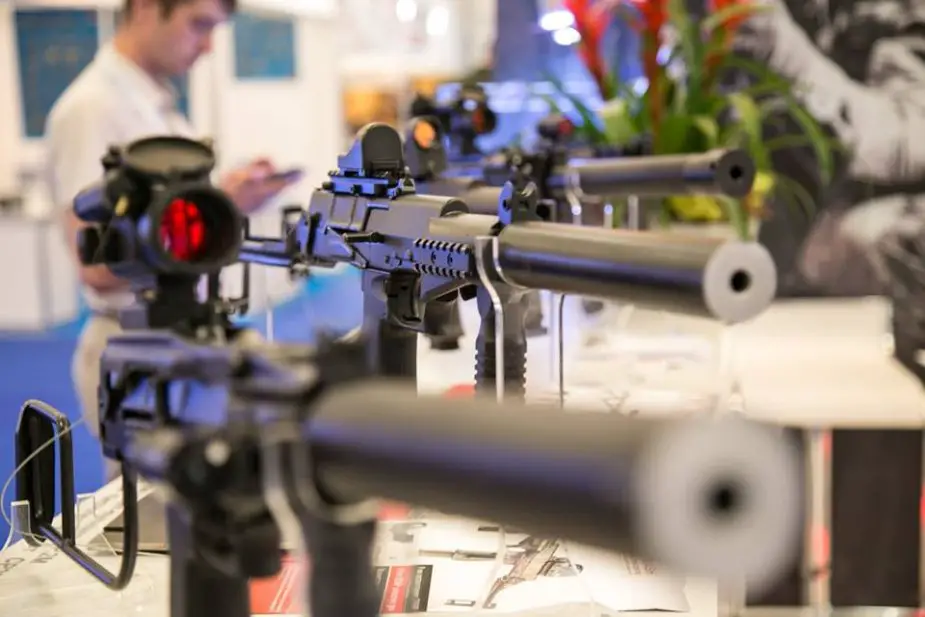Russia maintains second position in global arms trade
In 2017, the Russian Federation retained the second place in the list of the world`s biggest arms exporters, a study issued by the Stockholm International Peace Research Institute (SIPRI) says.

(Credit: Rostec)
According to SIPRI`s "Trends in International Arms Transfers, 2017" report, Russia`s share of the global arms market was 22 percent in 2013-2017, with India, China and Vietnam being the largest importers of Russian-originated hardware. The abovementioned three countries accounted for 35 percent, 12 percent, and 10 percent of Russian arms imports within the prescribed period, respectively.
However, there was a slight fall compared with the previous period, 2008-2012." Russian arms exports decreased by 7.1 percent between 2008-12 and 2013-17," the authors of the study say. According to the specialists from SIPRI, traditional importers of Russian weapons continued to order hardware, however, sometimes in lesser quantities. At the same time, some countries almost dropped out from the list of Russia`s clients in military-technical area, for instance, Venezuela, which was ranked 25th in the Top-40 list of the world`s biggest arms importers in 2013-2017.
The study by SIPRI says that Russia exported defense items of hardware to 47 states within the prescribed period, with three biggest importers (India, China and Vietnam as mentioned earlier) accounting for 58 percent of the exports. The shares of the Asia-Pacific region, Africa, the Middle East, Europe and the Americas reached 66 percent, 13 percent, 11 percent, 6.2 percent, and 4.2 percent, respectively.
It should be mentioned that five world`s biggest exporters of arms, namely, the United States of America (USA), Russia, France, Germany and China accounted for 74 percent of the defense exports in 2013-2017, the specialists of SIPRI say.
According to the study, India, Saudi Arabia and Egypt were the world`s biggest importers of weapons within the prescribed period. They accounted for 12 percent, 10 percent, and 4.5 percent of the global arms imports, respectively. It is noteworthy that the United Arab Emirates held the fourth place in the list of the biggest arms importers in 2013-2017, having secured a share of 4.4 percent of the global arms imports.
The report issued by SIPRI shows that Russia had strong positions on the arms markets of several countries in 2013-2017. For instance, India and China acquired 62 percent and 65 percent of their defense imports from Russia within the prescribed period. Moscow also dominated the market of Vietnam and Venezuela, accounting for 85 percent and 66 percent of the countries` arms imports, respectively. Moreover, Russia had a large share of the defense market of former Soviet republics. In particular, Kazakhstan acquired 78 percent of its arms imports from Russia, while the share of Russian-originated hardware in the structure of Azerbaijan`s arms imports reached 65 percent within the prescribed period. According to SIPRI, Egypt, Iraq, Bangladesh, Afghanistan and Myanmar were among Russia`s most important partners in 2013-2017.
Turning to the regional structure of the Russian defense exports, it should be mentioned that Moscow accounted for 39 percent of defense supplies to the African region in 2013-2017, the analysts of the institute say. Russia also accounted for 27 percent of deliveries to South America, beating the United States and France. Moscow was the biggest exporter of defense hardware to the Asia-Pacific region (34 percent of the arms deliveries to the region), leaving behind the United States and China.
The competition between the United States and Russia on the global arms market has stirred up. According to the abovementioned SIPRI`s study, Washington had a share of 34 percent of the arms market in 2013-2017, while Russia, as mentioned earlier, accounted for 22 percent. Therefore, the combined share of both countries slightly exceeded 50 percent. It is noteworthy that France emerged as the third biggest arms exporter (6.7% of major arms exports within the prescribed period), outshining Germany (5.8% of major arms exports), China (5.7% of major arms exports) and the United Kingdom (4.8% of major arms exports).
Despite sanctions imposed by Western countries, Russia remains a high-profile player on the global arms market. In March, presidential aide for military-technical cooperation Vladimir Kozhin told Russian media that Moscow had exported defense hardware worth USD16 billion last year and had signed contracts worth USD16 billion for the delivery of equipment. The volume of the Russian backlog of export orders had reached USD45 billion, with 50 percent accounted by MENA (the Middle East and North Africa) countries. According to Kozhin, MENA states are followed by China and India. Aviation hardware had accounted for more than 50 percent, land systems - for 20 percent, air defense assets - for 10 percent, and naval hardware - for 10 percent, the aide emphasized. It is noteworthy that last year India held the fifth place in the list of importers of Russian-made defense equipment. According to Kozhin, the volume of Russia`s obligations under contracts with China reached USD6 billion (or 14.44 percent of the order backlog), including S-400 Triumf (NATO reporting name: SA-21 Growler) air defense systems, Sukhoi Su-35 multirole combat aircraft (Flanker-E+), Beriev Be-200 and Be-103 amphibious planes, Kamov Ka-32A11BC and Mil Mi-171 utility helicopters, Ansat light rotorcraft, aviation engines, and research-and-development works.
According to Russian experts, Moscow was successfully developing military-technical cooperation with foreign partners last year. The Eksport Vooruzheniy (Arms Exports) magazine issued by the Center for Analysis of Strategies and Technologies (CAST) says that nobody could predict so-called ‘Middle Eastern breakthrough’. Not only did Russia sign a contract for the delivery of the S-400 system to Turkey, but Moscow also entered the arms market of Saudi Arabia and other countries of the region. Therefore, Moscow gained a significant success, as the estimated deal with Saudi Arabia is worth USD3.5 billion. The contracts with this country also envisage infrastructure projects to transfer technologies to Riyadh and to build manufacturing capacities there, the authors of the magazine add.

























